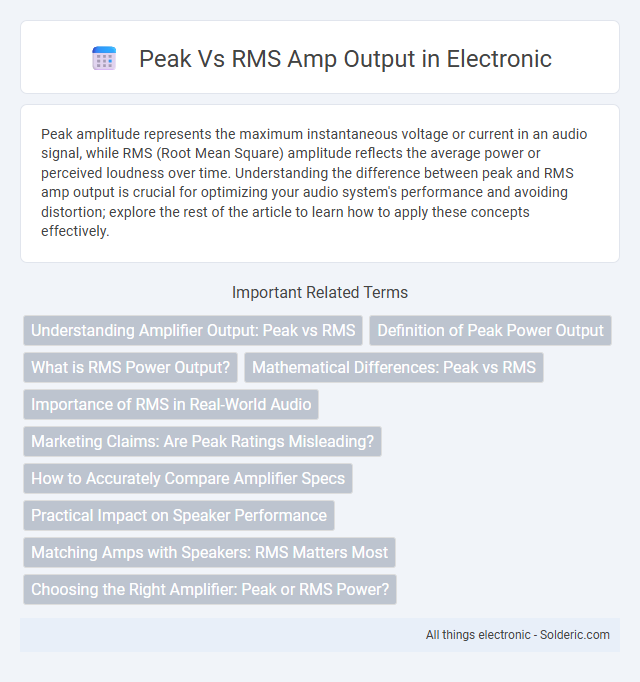Peak amplitude represents the maximum instantaneous voltage or current in an audio signal, while RMS (Root Mean Square) amplitude reflects the average power or perceived loudness over time. Understanding the difference between peak and RMS amp output is crucial for optimizing your audio system's performance and avoiding distortion; explore the rest of the article to learn how to apply these concepts effectively.
Comparison Table
| Feature | Peak Amplitude Output | RMS Amplitude Output |
|---|---|---|
| Definition | Maximum instantaneous amplitude value | Root Mean Square value representing average power |
| Measurement | Highest voltage or current at a specific time | Effective continuous power over time |
| Use Case | Captures signal peaks, useful for transient analysis | Reflects actual energy output, relevant for power ratings |
| Signal Type | Applicable to dynamic, transient signals | Best for steady-state or periodic signals |
| Relation | Peak 1.414 x RMS (for sine waves) | RMS Peak / 1.414 (for sine waves) |
| Importance in Audio Amplification | Determines max headroom and clipping point | Represents continuous power driving speakers |
Understanding Amplifier Output: Peak vs RMS
Amplifier output is measured in both peak and RMS (Root Mean Square) values, with peak representing the maximum instantaneous power the amplifier can deliver, while RMS indicates the continuous power output over time. RMS is considered a more accurate measure of an amplifier's true power capability because it reflects the sustained energy delivered to the speakers without distortion. Understanding the difference between peak and RMS outputs helps in selecting amplifiers that match speaker specifications for optimal sound performance and system reliability.
Definition of Peak Power Output
Peak power output refers to the maximum instantaneous power an amplifier can deliver to a load without distortion or damage. It represents the highest amplitude level that the amplifier can reach in short bursts, typically measured in watts. Peak power is crucial for handling transient audio signals, such as sudden loud sounds, ensuring clean and undistorted amplification during these moments.
What is RMS Power Output?
RMS power output measures the continuous power an amplifier can deliver to a speaker without distortion or damage, reflecting the amplifier's true performance during regular use. Unlike peak power, which indicates the maximum power level for a brief moment, RMS focuses on sustained power levels that affect sound quality and reliability. Understanding RMS power helps you select an amplifier that matches your speaker's requirements for optimal audio performance and durability.
Mathematical Differences: Peak vs RMS
Peak amp output measures the maximum instantaneous voltage of a signal, indicating the highest point the waveform reaches, while RMS amp output represents the equivalent continuous power by calculating the root mean square of the voltage over time. Mathematically, the RMS value is derived by squaring the instantaneous values, averaging them, and then taking the square root, providing a measurement that correlates to the actual energy delivered. Understanding the distinction between peak and RMS values helps you accurately assess and match amplifier power ratings to your audio system's requirements.
Importance of RMS in Real-World Audio
RMS (Root Mean Square) amp output provides a more accurate measure of continuous power delivery in real-world audio, ensuring your speakers receive consistent energy without distortion. Unlike peak power, which only indicates maximum short bursts, RMS reflects sustained performance critical for balanced sound reproduction and system reliability. Understanding RMS values helps you choose amplifiers that match your audio setup's demands, protecting equipment and enhancing listening experience.
Marketing Claims: Are Peak Ratings Misleading?
Peak amp output ratings often appear more impressive in marketing but can be misleading because they represent short bursts of maximum power rather than continuous performance. RMS (Root Mean Square) ratings provide a more accurate measurement of an amplifier's sustained power delivery and reliability during regular use. Consumers should prioritize RMS specifications for a realistic understanding of an amplifier's true performance capabilities.
How to Accurately Compare Amplifier Specs
Peak and RMS amplifier outputs represent different measures of power, with peak indicating the maximum instantaneous power and RMS reflecting the continuous power an amplifier can deliver. To accurately compare amplifier specs, prioritize RMS wattage as it provides a realistic assessment of consistent performance, ensuring you understand your device's reliable output capacity. Always check that peak power ratings are not misleading by confirming corresponding RMS values for a true comparison.
Practical Impact on Speaker Performance
Peak amp output measures the maximum instantaneous power your speaker can handle without distortion, while RMS (Root Mean Square) amp output reflects the continuous power level it can sustain over time. Higher RMS ratings are more reliable indicators of a speaker's consistent performance, ensuring durability and sound quality during extended use. Understanding the difference between these metrics enables you to match amplifiers and speakers effectively, preventing damage and optimizing audio clarity.
Matching Amps with Speakers: RMS Matters Most
When matching amps with speakers, RMS (Root Mean Square) power ratings provide a more accurate measure of continuous power handling, ensuring consistent performance without damage. Peak power ratings represent short bursts of power that speakers can tolerate briefly but do not reflect sustainable output levels. Prioritizing RMS power matching helps prevent distortion and speaker damage, promoting longevity and reliable sound quality.
Choosing the Right Amplifier: Peak or RMS Power?
Choosing the right amplifier depends on understanding the difference between peak and RMS power ratings, where RMS (Root Mean Square) reflects the continuous power an amplifier can deliver safely without distortion. Peak power ratings indicate the maximum output an amplifier can achieve momentarily but may not sustain over time, leading to potential damage or audio clipping. To ensure reliable performance and protect your speakers, prioritize the RMS power rating that matches your speaker's continuous power handling capacity rather than peak values.
Peak vs RMS amp output Infographic

 solderic.com
solderic.com